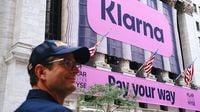Klarna, the Swedish fintech giant known for its buy now, pay later (BNPL) services, made a triumphant return to public markets this week, debuting on the New York Stock Exchange (NYSE) under the ticker KLAR. The company’s long-awaited initial public offering (IPO) was priced at $40 per share—well above its initial guidance range of $35 to $37—raising nearly $1.4 billion and securing a valuation just over $15 billion, according to Fast Company and DailyFX. The blockbuster listing is already being hailed as one of the most closely watched fintech IPOs of 2025, capping off a week in which Wall Street closed at record highs and global equities surged in parallel.
Klarna’s journey to the NYSE was anything but straightforward. The company originally filed registration documents in March 2025, but the Trump administration’s so-called “Liberation Day” tariffs and market volatility forced Klarna and several other tech firms to delay their public debuts. The dust has now settled, and Klarna’s leadership felt the timing was finally right, especially as other tech companies like Circle and Figma also went public in recent months. The IPO leads a packed week in New York, with seven companies planning to go public by Friday—marking the busiest IPO week in years, according to Reuters.
Founded in 2005, Klarna has become a household name in the BNPL sector, allowing customers to split purchases into installments without traditional credit checks. The service gained tremendous momentum during the pandemic as online shopping boomed. Klarna’s global reach is impressive: it operates in 26 countries, and the United States has emerged as its largest market by volume. The company holds full banking licenses in Europe and offers not just BNPL but also credit and debit card services, as reported by Fast Company and other outlets.
Despite its ambitious global expansion, Klarna’s path has not been without setbacks. The company reported a $52 million net loss in the second quarter of 2025, up from an $18 million loss in the same period the previous year. Customer defaults contributed to an even larger $99 million loss in the first quarter. Yet, CEO Sebastian Siemiatkowski pointed to a silver lining: Klarna achieved record on-time payment rates in Q2, a sign that the company’s risk management efforts may be paying off. The company was profitable for its first 14 years, and recent losses have been attributed to aggressive U.S. expansion and investments in global growth, according to CNBC.
It’s worth noting that Klarna’s IPO valuation of $15.1 billion marks a significant recovery from its low point in 2022, when the company’s valuation plummeted to $6.7 billion during the broader tech downturn. At its peak in 2021, Klarna was valued at a staggering $45.6 billion, riding high on the pandemic-fueled BNPL rush. The current valuation, while a step down from those dizzying heights, signals renewed investor confidence and a more stable footing for the company as it enters the next phase of its growth journey.
Market analysts have praised Klarna’s conservative pricing strategy, which appears to have generated robust investor demand. The company offered 34.3 million shares, representing about 9% of its total outstanding shares. Trading began Wednesday morning, and shares quickly jumped, reflecting the upbeat mood that has characterized global markets in recent days. According to IG Markets, Wall Street’s record highs were mirrored across Asia, with Taiwan’s benchmark index hitting an all-time peak and Japan’s Nikkei 225 rallying back toward historic levels. European stock indices also pointed higher as investors leaned into risk assets.
The broader market backdrop has played a key role in Klarna’s successful debut. The Federal Reserve remains at the center of investor attention, with expectations mounting that the Fed will deliver policy easing at its upcoming September 17 meeting. Markets are currently pricing in 66 basis points of easing by year-end, and the CME FedWatch tool shows an 8% probability of a larger 50-basis-point cut next week. Most investors still expect at least a quarter-point reduction, with sentiment buoyed by the belief that aggressive easing could stave off a U.S. recession. Producer and consumer price data due this week could prove decisive in shaping the Fed’s next move. A hot inflation print, however, could reignite fears of stagflation and potentially limit the scale of rate cuts, as observed by DailyFX.
Commodities and geopolitics have added further layers to the market narrative. Gold steadied after touching a record high on Tuesday, while the U.S. dollar was little changed in anticipation of inflation data. Meanwhile, crude oil extended gains following Israel’s strike on Hamas leadership in Qatar, and regional tensions remained elevated after Poland and NATO scrambled air defenses in response to Russian drone attacks on western Ukraine.
For Klarna, the IPO represents more than just a financial milestone—it is a testament to the vision and tenacity of its founders. Mattias Ljungman, cofounder and Managing Partner at Moonfire and an early investor in Klarna, told Fast Company that the company’s founders stood out for their relentless focus and transformative vision. "The main thing was the founders. They had some really exciting people with the capability to drive transformative change in the market. Sebastian [Siemiatkowski, Klarna’s cofounder and CEO] had it in spades—he’s relentless, tenacious, passionate, and he was fixated on his vision," Ljungman said. He added that Klarna’s other cofounders, Niklas Adalberth and Victor Jacobsson, were “great people and great operators.”
Ljungman also highlighted Klarna’s unique position in the payments ecosystem. "What Klarna did was build out a separate set of rails for commerce," he explained, noting that the company has become a sort of conversion engine for merchants, offering them valuable customer insights and helping facilitate more sales. Klarna’s strategy, he believes, positions it as a viable third player alongside giants like Visa and Mastercard.
The company’s next big challenge? Breaking through in the U.S. market. While Klarna has already made significant inroads, Ljungman cautioned that success will require time and considerable resources. Still, he remains optimistic, having seen Klarna thrive in market after market. "Every time, they’ve nailed it," he said.
As Klarna embarks on its new chapter as a public company, the stakes are high. The company must balance its ambitions for U.S. expansion with the need to return to profitability, all while navigating an increasingly competitive BNPL landscape. With its founders’ vision, a strong market debut, and renewed investor confidence, Klarna is well-positioned to shape the future of digital payments on a global scale.






